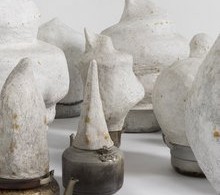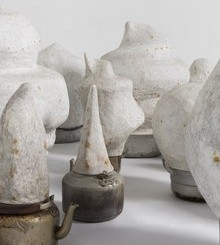Li Gang (*1986, lives and works in Beijing) digs deep into everyday life to find materials that make the strongest statements. Out of these he produces his thoroughly classical-looking works of art. He works with exhaust pipes, cement, rebar, jade bracelets, plaster, human hair, hemp rope, bank notes, stones, and rubbish. Our exhibition in Lucerne features sculptures and oil paintings from a variety of series.
For the sculptural piece False or True (2014 – 2016, cement, lime, stainless steel, dimensions vary from 12 x 16 x 16 cm to 24 x 26 x 23 cm [sculptures], 50 x 45 x 50 cm [stainless steel structures]), which is now in its final stages, Li Gang has built a machine that draws humidity out of the surrounding air and transforms it into cement by constantly dripping it into a container full of cement. Atmosphere is made visible. These accidently beautiful, solidified chunks of concrete are presented in a three-dimensional framework made of stainless steel bars. They resemble so-called Chinese scholar’s rocks—natural stones that are set up in scholars’ rooms for the purpose of contemplating them. One of Li Gang’s devices is to use the material most symbolic of China’s extreme progress, which was used to build the Three Gorges dam, endless miles of streets, and countless buildings. In the years since 2012 China has produced more cement than the United States has manufactured since 1900.
Li Gang’s series Gravity (2016, jade bracelets, steel tubes, dimensions vary from 290 x 80 x 60 cm to 356 x 100 x 75 cm) was built of reinforced steel, the second kind of material that has made China’s rapid urbanization possible. Piece by piece, Li welded together the metal in a process that resembles that of a construction worker’s. He threaded jade bracelets into some of the sections, then affixed them to the sculpture with more welded metal. The delicate works thus constructed refer to the relationships among the people who deal with these materials: the hoards of women and men who migrate through the country searching for ways to earn a living, drawn to the centers of economic progress as if by gravity. Like the process of making Li’s sculptures, these people are always adjusting to something new, adapting to new conditions.
A mixture of plaster and hair cut from the heads of Chinese migrant workers rises like condensed steam or fragile dollops of whipped cream out of old kettles and pots left behind by these contemporary nomads on their travels to far-distant factories and construction sites. Yet, an analysis of the hair could reveal everything about the identities and lifestyles of the individual hair salon customers. Via these biographical tracks, left behind every few weeks, anyone can imagine the routes these people have taken. For Desserts (2015, plaster, rebar, hair, discarded kettles and pots, dimensions vary from 41 x 30 x 23 cm to 92 x 76 x 76 cm) the hair was randomly swept up and mixed with plaster, according to traditional construction methods, to produce anonymous construction materials. With these Desserts Li Gang succeeds at precisely analyzing the contemporary phenomenon of worker migration inside of China.
His latest Oilpaintings (2016, oil on hand-made canvas, dimensions vary from 125 x 122 cm to 160 x 163 cm), which will also be on display in the Lucerne show, are linked to Li’s homeland of Yunnan in South China, where he had the canvas for his paintings woven out of raw hemp by local craftspeople. On these canvases he paints enlarged details of source material derived from art history and his own environment. With their exaggerated dimensions and natural flesh tones, the broad brushstrokes on rough textiles have a direct effect on the viewer’s physical presence; no one is used to feeling so deeply immersed in a painting—a sensation caused by an optically deceptive proximity.
The young artist shifts with absolute certainty through various media, such as sculpture, installation, and painting. Every one of Li Gang’s groups of works can assert its extreme individuality, yet at the same time, each can be traced back to its own completely unique, intense exploration of its environment and the themes that result from this process, as well as to the experiences of life, loss, and transformation. Using the materials and motifs he chooses regardless of their value, Li Gang creates works that make strong statements about place, time, and society. His works keep pace with sociological and philosophical analyses, and provide substantial material for the discourse, as well as for the realities of life in China.


